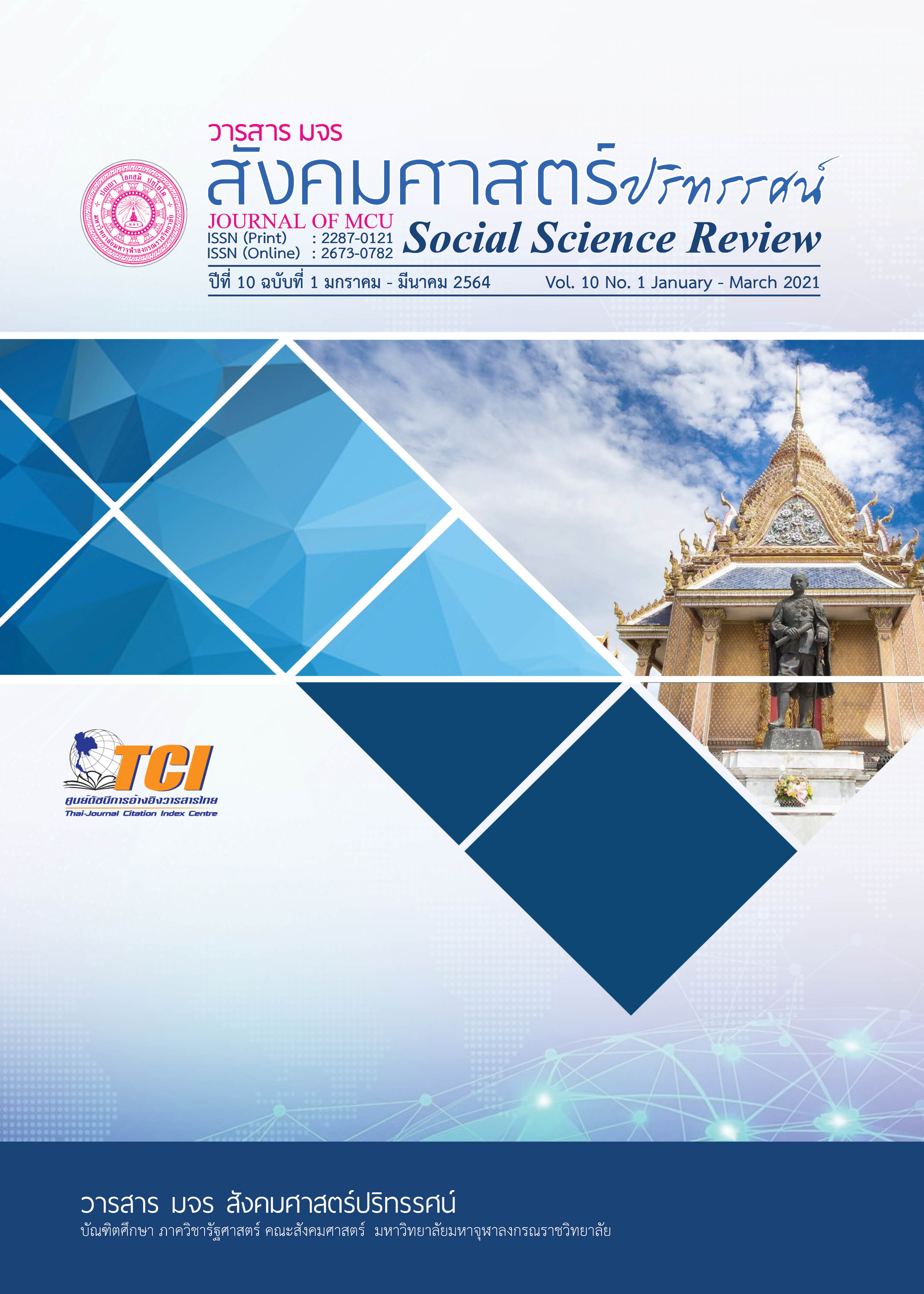HAZE POLLUTION: VULNERABILITY AND SOCIAL IMPACT AT HOUSEHOLD LEVEL
Keywords:
Haze Pollution, Vulnerability, Social ImpactAbstract
Objectives of this survey research were to investigate the social impacts of haze pollution problem and vulnerability factors influencing social impacts arising from the haze pollution problem in the area of households in Baan Kor Mor 36, Aiyerrweng Sub-district, Betong District, Yala Province. Data were collected from samples of 217 households with questionnaires. The data analysis was divided into two parts. Firstly, data analysis was conducted to determine mean and standard deviation to analyze social impacts. Secondly, One-way ANOVA was used to analyze vulnerability factors influencing social impacts. The results of the study indicated that households in Baan Kor Mor 36 were the most affected by fear and anxiety at a relatively high level. The vulnerability factors influencing social impacts were general household information, risk behavior of household members, household potential, and spatial precariousness. The four aspects influenced the social impacts with a statistical significance level of .05 The findings reflected that these vulnerability factors of households in Baan Kor Mor 36 influenced the social impacts in the haze pollution.
References
กรมป้องกันและบรรเทาสาธารณภัย. (2559). การลดความเสี่ยงจากภัยพิบัติ. กรุงเทพฯ: บริษัท เวิร์ค พริ้นติ้ง จำกัด.
กลุ่มเวชศาสตร์สิ่งแวดล้อม สำนักโรคจากการประกอบอาชีพและสิ่งแวดล้อม กรมควบคุมโรค กระทรวงสาธารณสุข. (2559). คู่มือเฝ้าระวังผลกระทบต่อสุขภาพจากปัญหาหมอกควันสำหรับบุคลากรสาธารณสุข (ฉบับปรับปรุง 2559). นนทบุรี: กรมควบคุมโรค กระทรวงสาธารณสุข.
ประสพชัย พสุนนท์. (2557). การกำหนดขนาดตัวอย่างตามแนวทาง Krejcie and Morgan (1970) ในการวิจัยเชิงปริมาณ. วารสารวิชาการศิลปศาสตร์ประยุกต์, 7(2), 112-125.
ศิริชนก วิริยะเกื้อกูล. (2559). มลพิษหมอกควันข้ามแดน. สืบค้น 22 กันยายน 2563, จาก https://www.parliament.go.th/ewtadmin/ewt/parcy_train/ewt_dl_link.php?nid=36607
สำนักข่าวกรมประชาสัมพันธ์. (2562). เจ้าหน้าที่ป่าไม้ ในอ.เบตง จ.ยะลา สนธิกำลังหลายหน่วยงานเดินเท้าลุยปราบมอดไม้เข้มข้นติดต่อกัน พบมอดไม้บุกรุกป่าพระนามาภิไธยภาคใต้ พื้นที่ส่วนที่ 2 (ป่าสิริกิติ์) ถูกทำลายใหม่จำนวนหลายแปลง. สืบค้น 22 กันยายน 2563, จาก https://thainews.prd.go.th/th/news/detail/TCATG190522170504196
สำนักงานสถิติแห่งชาติ. (2562). สถิติรายได้และรายจ่ายครัวเรือน. สืบค้น 22 กันยายน 2563, จาก http://statbbi.nso.go.th/staticreport/page/sector/th/08.aspx
องค์การบริหารส่วนตำบลอัยเยอร์เวง. (2558). แผนพัฒนาตำบลอัยเยอร์เวง. สืบค้น 22 กันยายน 2563, จาก http://www.iyerweng.go.th/datacenter/doc_download/a_170714_150743.pdf
Agarwal, S. et al. (2020). The Impact of Transboundary Haze Pollution on Household Utilities Consumption. Energy Economics, 85, 1-25.
ASEAN Specialised Meteorological Centre (ASMC). (2018). ASMC Bulletin. Retrieved September 23, 2020, from http://asmc.asean.org/publication-biannual-bulletin-feb-2018/
Chen, Q. et al. (2020). Associations between Individual Perceptions of PM 2.5 Pollution and Pulmonary Function in Chinese Middle Aged and Eldery Residents. BMC Public Health, 20(899), 1-9.
Ge, Y. et al. (2017). Mapping Social Vulnerability to Air Pollution: A Case Study of the Yangtze River Delta Region, China. Journal of Sustainability, 9(1), 1-15.
Ghani, F., A. et al. (2017). Review on ASEAN Transboundary Haze Pollution Agreement 2002: Problems and Solutions. Journal of Humanities, Language, Culture and Business (HLCB), 1(1), 153-161.
James, M. V. (2017). Urban and Rural Inequality in Knowledge, Attitude, and Practice on Haze Pollution Episode in Klang Valley, Malaysia. Malaysian Journal of Public Health Medicine, Special volume (1), 157-162.
Kuy, M., S. (2014). Front piece for transboundary haze pollution (THP). Retrieved September 22, 2020 from http://researchgate.net/publication/308169443_Front_piece_for_transboundary_haze_pollution_THP
Low, B. S. et al. (2020). Education Background and Monthly Household income are Factors Affecting the Knowledge, Awareness and Practice on Haze Pollution among Malaysians. Evironmental Science and Pollution Research, 27, 30419-30425
Muñoz-Pizza, D., M., et al. (2020). Assessing the Influence of Socioeconomic Status and Air Pollution Levels on the Public Perception of Local Air Quality in a Mexico-US Border City. International Journal of Environmental Research and public health, 17(13), 1-22
Sunchindah, A. (2015). Transboundary Haze Pollution Problem in Southeast Asia: Reframing ASEAN’s Response. Retrieved October 14, 2020, from https://www.eria.org/ERIA-DP-2015-82.pdf
United Nations Office for Disaster Risk Reduction (UNDRR). (2016). Report of the open-ended intergovernmental expert working group on indicators and terminology relating to disaster risk reduction. Retrieved September 22, 2020, from https://www.preventionweb.net/files/50683_oiewgreportenglish.pdf
Vanclay, F. (2003). International Principles For Social Impact Assessment. Impact Assessment and Project Appraisal, 21(1), 5-11.
Varkkey, H. (2014). Regional cooperation, patronage and the ASEAN Agreement on transboundary haze pollution. International Environmental Agreements: Politics, Law and Economics, 14(1), 65-81.
Downloads
Published
How to Cite
Issue
Section
License
Copyright (c) 2021 Journal of MCU Social Science Review

This work is licensed under a Creative Commons Attribution-NonCommercial-NoDerivatives 4.0 International License.
In order to conform the copyright law, all article authors must sign the consignment agreement to transfer the copyright to the Journal including the finally revised original articles. Besides, the article authors must declare that the articles will be printed in only the Journal of MCU Journal of Social Sciences. If there are pictures, tables or contents that were printed before, the article authors must receive permission from the authors in writing and show the evidence to the editor before the article is printed. If it does not conform to the set criteria, the editor will remove the article from the Journal without any exceptions.





